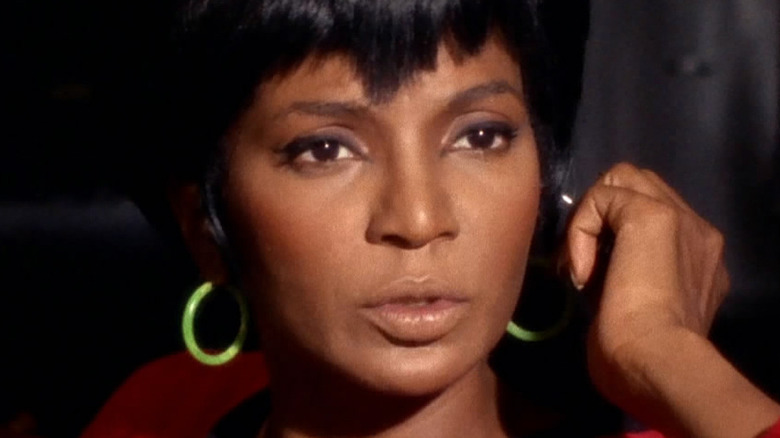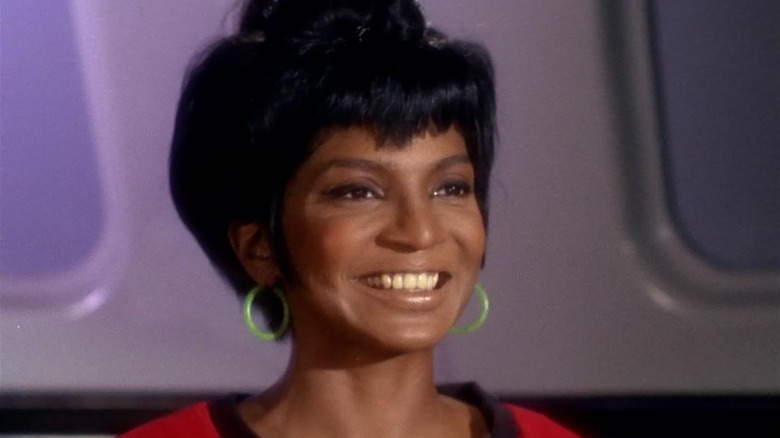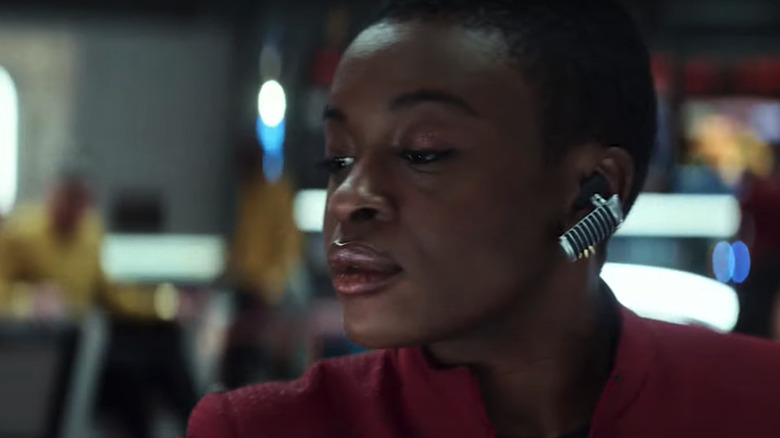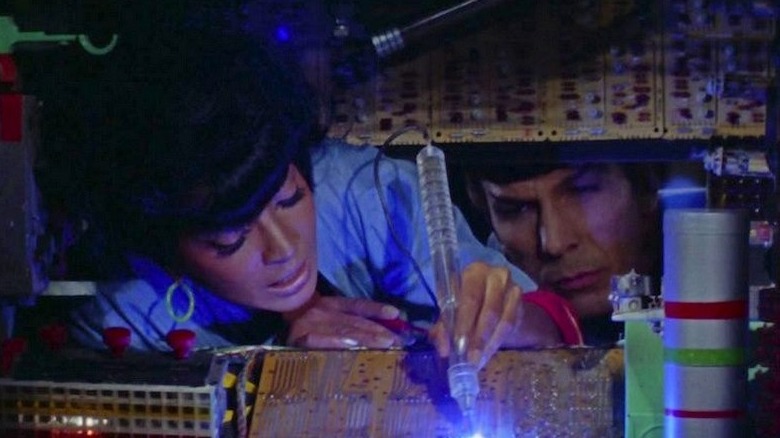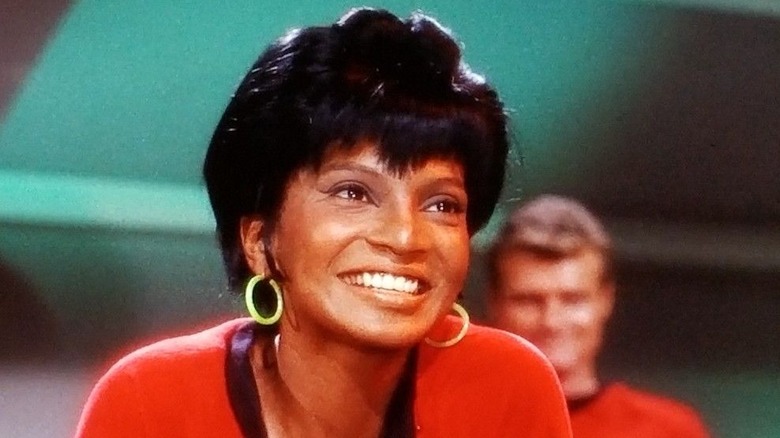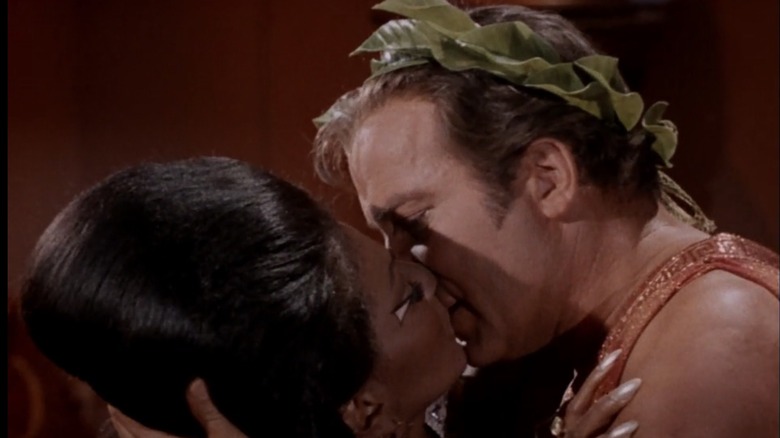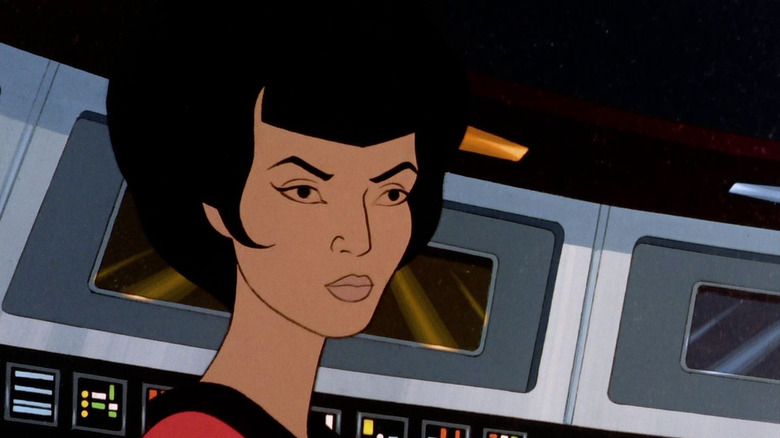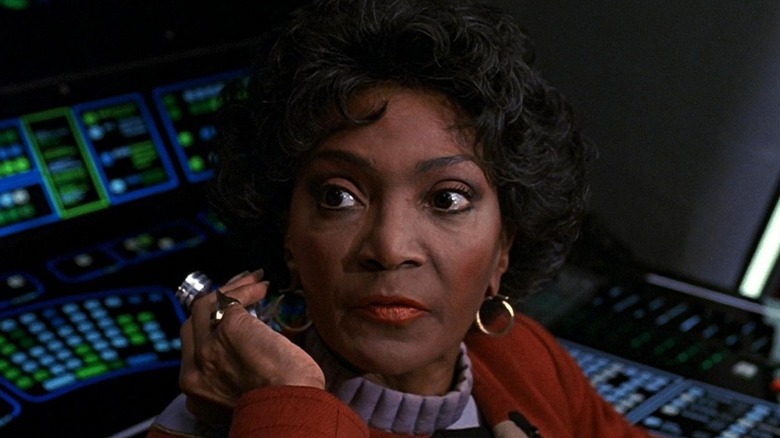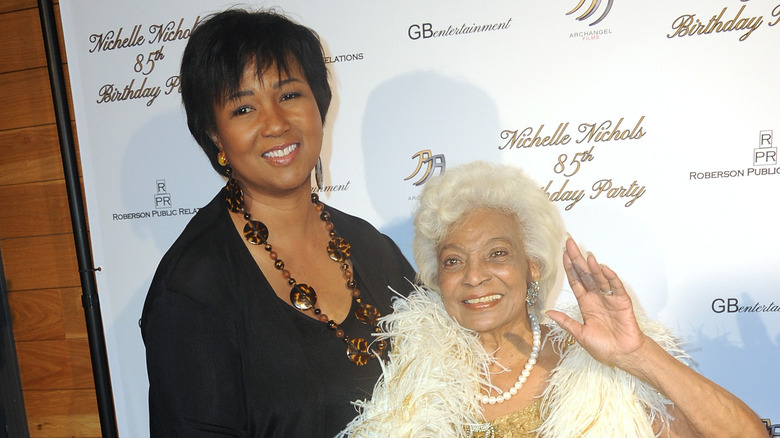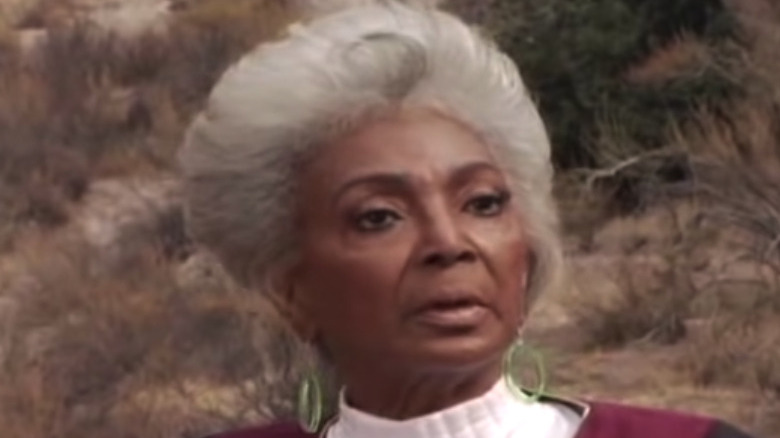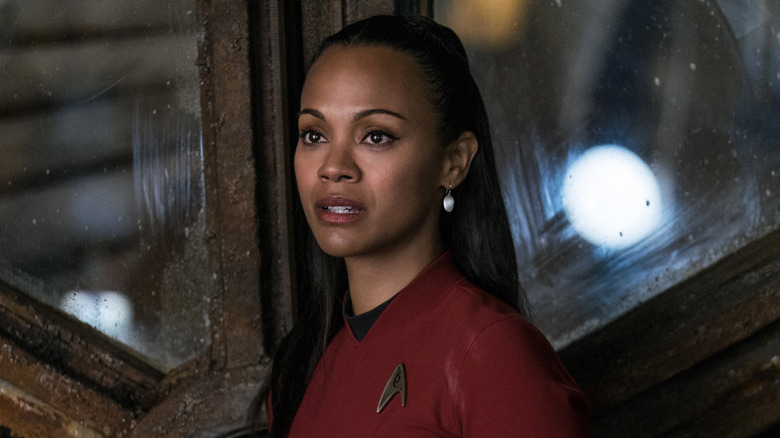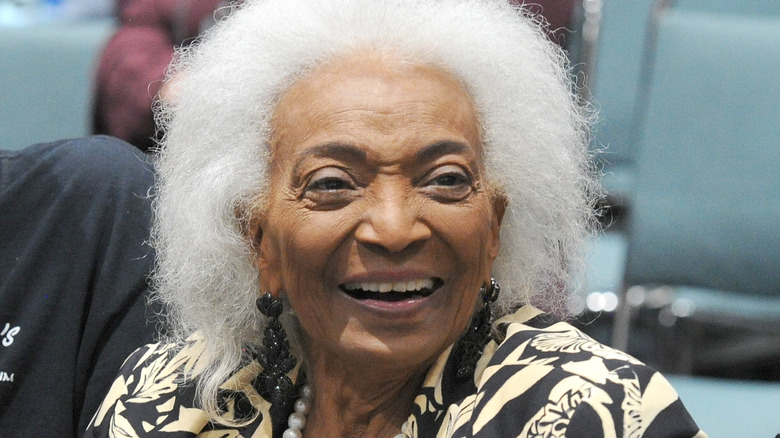The Untold Truth Of Star Trek's Nyota Uhura
As a member of the original "Star Trek" crew, Lieutenant (and later, Commander) Nyota Uhura is a sci-fi legend. First appearing on television in 1966, Uhura was one of the first Black women to be depicted in a position of authority on American television. Following three seasons of the original "Trek," the character appeared in nine feature films (first portrayed by Nichelle Nichols and later by Zoë Saldana) and is about to make a more substantive return as part of the regular cast of the new streaming series "Star Trek: Strange New Worlds," where she'll be played by Tony Award nominee Celia Rose Gooding.
While Uhura is practically omnipresent on "Star Trek: The Original Series" – appearing in more episodes than famous colleagues Scotty, Sulu, or Chekov — the "Trek" canon has provided scant few details about her backstory, personal life, or career apart from her decades-long tenure as Chief Communications Officer aboard the USS Enterprise. Thankfully, not only do official "Star Trek" novels and reference materials fill in some of the details, but the behind-the-scenes story of Uhura's evolution and contribution to American television has been very well documented. While we wait for "Strange New Worlds" to open a new chapter in Uhura's story, here's a quick look back at her legacy so far.
Nichelle Nichols gave Uhura her name
Actor Nichelle Nichols did more than perform the role of Lt. Uhura, she also played a substantial part in shaping and inspiring the character. According to her memoir, "Beyond Uhura: Star Trek and Other Memories," Nichols and future "Star Trek" creator Gene Roddenberry first met in 1963 on the set of his previous television series, "The Lieutenant," after which they began a months-long romantic relationship. During their time together, Roddenberry would make vague references to a science fiction project he'd been working on, which he called "Wagon Train to the Stars." Years later, while Nichols was on tour as a singer in Paris, she received a telegram from her agent telling her that she had an important audition for "Star Trek" — whatever that was.
Nichols was invited to audition for "Star Trek" before any specifics about her character had been decided. Since her part had yet to be written, she actually auditioned by reading scenes written for Spock. While waiting for her meeting with Roddenberry and his production team, Nichols was immersed in reading the novel "Uhuru" by Robert Ruark. Uhuru is Swahili for "freedom," and (according to the documentary "Woman in Motion") Nichols suggested that this be repurposed as her character's surname. Accounts vary as to when the first name of "Nyota" was decided upon, but it first appeared in the 1982 reference book "Star Trek II: Biographies," and did not become canon until its use in the 2009 "Star Trek" film.
Uhura's early life is yet to be depicted on screen
Most of Uhura's life before she joined the crew of the USS Enterprise has only been represented in non-canonical novels, which might be retconned by her appearances in the upcoming "Strange New Worlds." According to the novels "The Starless World" and "Catalyst of Sorrows," Uhura was born and raised in Kenya, which in the 23rd Century is part of the United States of Africa. As a teenager, she attends the Institute for Advanced Mathematics prior to being accepted into Starfleet Academy. "Beyond Uhura" explains that Nichelle Nichols and Gene Roddenberry imagined Uhura as Spock's protégé, an association that is supported by their interactions on "The Original Series" and expanded upon in the alternate "Kelvinverse" of 2009's "Star Trek" feature film.
Most non-canonical works depict Uhura's Academy years overlapping with that of her future commanding officer, James T. Kirk, and that may not be contradicted by her appearance on "Strange New Worlds." On the new series, Uhura is a fourth-year Academy cadet on assignment to the USS Enterprise. Since "Strange New Worlds" is set after the second season of "Star Trek: Discovery," it can begin no later than 2258, by which time Kirk would have already been a lieutenant serving aboard the USS Farragut — which doesn't preclude their having met there. What "Strange New Worlds" does change is that, while Kirk is the name most famously associated with the USS Enterprise, Uhura gets there first.
Uhura's job is actually really important
Lt. Uhura is unquestionably an underserved character on "Star Trek: The Original Series" and the subsequent films featuring the original cast, never getting the same spotlight as Kirk, Spock, McCoy, or even Scotty. While this is a completely fair criticism of the show, its producers and its writers, it has unfortunately led some fans and critics to diminish the character of Uhura herself and her role on the command staff of the USS Enterprise. At a glance, it's easy to see Uhura as the woman reduced to placing Captain Kirk's phone calls — after all, that's most of what she's seen doing in your average episode. While the underuse of Uhura is a glaring defect of the series, her contributions to the crew are not unimportant, merely underexposed.
As Chief Communications Officer, Uhura is the nerve center of a crew of over 400. She's a department head managing the rest of the communications staff, meaning anyone else you ever see at her post, plus other stations around the ship that we never see. She handles all inter- and intra-ship communications, including Kirk's orders from Starfleet and imperatives issued to the rest of the crew. Since the production of "Star Trek" predates our modern concept of networked computers, Uhura essentially is the network aboard the Enterprise, manually routing information across its hundreds of work consoles. Uhura being away from her station would basically be the equivalent of the internet going out on the ship.
Dr. Martin Luther King insisted Nichols remain on Star Trek
By the end of the first season of "Star Trek" in 1967, Nichelle Nichols was frustrated with how little her character actually got to do on the show. According to "Beyond Uhura," Nichols suffered a number of indignities during her time on "Star Trek" — her lines and subplots were frequently cut from the script, the studio secretly ordered the mail room not to deliver her fan letters, and studio representatives would make malicious racist comments directly to her face. Having had enough, she told Gene Roddenberry that she would be leaving the show to pursue a role on Broadway. Roddenberry asked her to take the weekend to think about it.
As fate would have it, Nichols was scheduled to attend a fundraising event for the civil rights organization NAACP the very next day. There, Nichols was introduced to "her greatest fan" — Dr. Martin Luther King, Jr. As recalled in "Beyond Uhura" and in interviews such as this one with the Washington Post, King told her that Uhura was an indispensable role model for viewers, particularly for Black children, who needed to envision themselves in a better future. Up to this point, she admitted in the documentary "Woman in Motion," Nichols had seen "Star Trek" as just another acting job. Now enlightened to the broader impact of her presence on the show (by one of the century's most compelling leaders, no less), Nichols retracted her resignation the following Monday and would remain for the duration of the series.
Uhura and Kirk's kiss made history
In the "Star Trek" episode "Plato's Stepchildren," Lt. Uhura and Captain Kirk are telekinetically compelled to kiss for the amusement of bored aliens. This caused quite a stir on set, according to "Beyond Uhura." Episode director David Alexander still insisted on capturing versions of the scene both with and without the kiss, in case NBC affiliates refused to air a kiss between Black and white performers. Nichelle Nichols and William Shatner performed the scene with the kiss first, insisting on dozens of takes from different angles. They left time for only one take without the kiss, which Shatner sabotaged by crossing his eyes directly into the camera. This assured that the show's producers would have no choice but to use one of the takes where the pair actually kisses.
Uhura and Kirk's kiss in "Plato's Stepchildren" is sometimes cited as "the first scripted interracial kiss on television," though this is an exaggeration — it's the earliest known kiss between white and Black actors on American TV, but actors of other differing races had kissed on TV previously, and outside the United States. Strictly speaking, "Plato's Stepchildren" wasn't even William Shatner's first interracial kiss on TV, as he and French-Vietnamese actress France Nuyen kissed while performing a scene from the play "The World of Suzie Wong" on "The Ed Sullivan Show" in 1958. (These two events do, of course, carry different cultural connotations.) The actual earliest known kiss between Black and white actors on TV took place on British television in 1962. Nevertheless, Uhura and Kirk's kiss remains an important moment in US television history, challenging cultural taboos during one of the most tumultuous years of the civil rights movement.
Uhura finally commands the Enterprise
Though high in the command structure of the USS Enterprise, Uhura never gets the chance to sit in the Captain's chair during "The Original Series" or any of her appearances in feature films. She does, however, get to briefly take the lead in "Star Trek: The Animated Series," the brief ink-and-paint revival of "Star Trek" that aired between the cancellation of "The Original Series" and the launch of the film franchise. In the 1973 episode "The Lorelei Signal," siren-like aliens from the Taurean system transfix and incapacitate the entire male population of the Enterprise, leaving the ship's remaining female officers to rescue them. Uhura (still voiced by Nichelle Nichols) takes command of the Enterprise and leads an away team comprised of herself, Nurse Chapel, and a number of female security officers who one must assume had always been just off-screen somewhere this whole time.
It's still a sad state of affairs that the storytellers behind "Star Trek: The Animated Series" felt they needed to arrange such a contrivance to get Uhura her moment in command, as if it would take every single man on the ship to be out of commission in order for her to get her turn. (It should have taken five, tops, which is still pretty damning of the show.) Would it be too much to ask that "Strange New Worlds" find an opportunity to give Cadet Uhura another (by which we mean "previous") turn at the big chair?
The novels detail Uhura's illustrious career
"Star Trek" made the leap to the big screen in 1979 with "Star Trek: The Motion Picture," in which Uhura still serves as Communications Chief aboard the refitted USS Enterprise. The classic crew mostly sticks together throughout the six films, which see the gang receive a string of promotions but still remain in their familiar posts with their found family. Uhura is last seen in "Star Trek VI: The Undiscovered Country" at the rank of Commander, but still far from, well, command.
Thankfully, Uhura's journey continues in print, via the ongoing series of "Star Trek" novels. In "Vulcan's Forge," Uhura serves as Spock's first officer aboard the USS Intrepid II, where she later succeeds him as captain. The short story "The Hero of My Own Life" sees her move on to a new command, the USS Hermes, where she serves as captain for over a decade. The novel "Catalyst of Sorrows" reveals that, at some time during this command, Uhura is secretly recruited into Starfleet Intelligence, and served concurrently at both posts for a period of decades. As human lifespans are significantly longer in the future of "Star Trek," Admiral Uhura is revealed to be alive and well and still working for Intelligence during the Dominion War (concurrent with "Star Trek: Deep Space Nine") at the age of 138. A contradictory tale in "The Autobiography of Jean-Luc Picard" mentions that she is elected President of the United Federation of Planets.
Nichelle Nichols changed the real-life space program
While Lt. Uhura was television's first Black astronaut, actress Nichelle Nichols leveraged her character's popularity to effect substantive change in the real-life US space program. Her involvement in real space activism began in 1975, when a NASA presentation at a "Star Trek" convention impressed upon her the homogeneity of NASA's white, male astronaut pool. Nichols decided to take it upon herself to create the change that her TV character was supposed to represent, writing editorials for newspapers and magazines questioning why the pool of American astronauts was not representative of the America around us.
These editorials got the attention of NASA, who invited her to cooperate in revamping their recruitment efforts for the upcoming class of space shuttle astronauts. Nichols agreed, but wisely did so as an independent contractor rather than as some sort of mascot. Not only did this preserve her credibility, but it also meant that she could hold NASA accountable if they didn't hold up their end — if she lined up the qualified candidates they asked for and NASA still hired only white men, she'd have the leverage to sue. Nichols spent the latter half of 1975 traveling the United States spreading her vision of the space program and personally recruiting much of the NASA Class of 1978, which would include America's first six female astronauts and first three African American astronauts.
Nichols' efforts for the space program are the center of the documentary "Woman in Motion."
Plans to bring Uhura back fell through
During the "Star Trek" renaissance of the 1980s and '90s, nearly every core member of "The Original Series" cast returned to make appearances on "Star Trek" offshoots — except for Nichelle Nichols. DeForrest Kelley, Leonard Nimoy and James Doohan each returned as special guests on "The Next Generation," Doohan joined William Shatner and Walter Koenig in the crossover film "Star Trek: Generations," George Takei and Grace Lee Whitney returned on an episode of "Voyager," but Nichols never officially reprised Uhura after 1991's "Star Trek VI." (She did appear in the unofficial miniseries "Star Trek: Of Gods and Men" produced by "Trek" alums in 2007.)
This isn't to say that Nichols was never invited to return to "Star Trek," but perhaps that no invitation was particularly enticing. In 1996, Nichols was offered a cameo in the "Star Trek: Voyager" episode "Flashback," which had a far more prominent role for her castmate George Takei as Captain Sulu. Nichols declined, feeling that her role was not significant enough to warrant her involvement. The most recent opportunity to bring Nichols back into "Star Trek" was a pitch for an episode of "Short Treks" in which an older Uhura would send a young Jean-Luc Picard on a mission. This episode has yet to be produced.
The movie reboot expands her role
In 2009, "Star Trek" was rebooted as a big-budget blockbuster film series featuring new versions of the original characters, with only Leonard Nimoy returning from the original cast as a time-displaced older Spock. Uhura, now portrayed by Zoë Saldana, had a much more prominent role in the new film series than she had previously. In addition to being depicted more explicitly as a genius polyglot whose skill with languages saves the crew on several occasions, she and James T. Kirk cross paths frequently at Starfleet Academy as Kirk is an infamous ne'er-do-well who also happens to be dating her roommate. The pair end up serving aboard the USS Enterprise together, where they eventually put aside their differences. Uhura also gets to participate more in the action-adventure side of "Trek" than her television counterpart, and has a romantic subplot with Spock that runs across all three films.
Zoë Saldana was offered the role of Uhura after already signing on to play Neytiri in James Cameron's sci-fi behemoth "Avatar." Saldana was initially hesitant to take on another demanding role with an overlapping production, prompting a summit between Cameron and "Star Trek" director J.J. Abrams to ensure that she wouldn't have to miss out on either opportunity. Saldana joined "Star Trek" with relatively little knowledge of the franchise, which is ironic — Saldana had previously portrayed a massive "Star Trek" fan in Steven Spielberg's 2004 film "The Terminal."
Uhura actress Nichelle Nichols died in 2022
Uhura will forever be hailed as an icon in the annals of science fiction history, and the character, no matter who plays her in the future, will surely continue to appear in future "Star Trek" reboots and spin-offs for as long as the franchise endures. However, as important as Uhura was to the television landscape, the woman who first brought her to life — the actor, singer, and activist Nichelle Nichols — was no less iconic.
Sadly, Nichols died on the night of July 30, 2022, as reported by Variety. Nichols had spent the last few years of her life diagnosed with dementia, per The Los Angeles Times. She is survived by her son Kyle Johnson, who was the one to reveal the news on her official Instagram account the morning after her death. There, Johnson wrote, "Last night, my mother, Nichelle Nichols, succumbed to natural causes and passed away. Her light however, like the ancient galaxies now being seen for the first time, will remain for us and future generations to enjoy, learn from, and draw inspiration."
